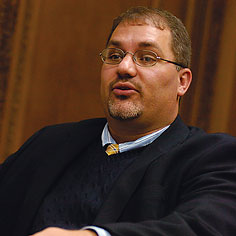

Robert Mays Creates Biotechnologies To Advance Medicine
In April 1997, Robert Mays received several phone calls after he and his colleagues published research findings in Nature Genetics describing their creation of the first artificial human chromosome. Mays assured callers that he was not part of an elaborate April Fool's Day prank, though understandably, their accomplishment was a feat many found hard to believe. Far from a joke, this work provided the foundation for a company that, in 2002, Red Herring magazine named one of the top 50 private companies most likely to change the world.
Together with John Harrington and Gil Van Bokkelen, fellow graduate students at Stanford University, Mays co-founded Athersys Inc., a biopharmaceutical company based in Cleveland.
A Research Scientist Emerges
Now the director of cell biology at Athersys, Mays attributes his passion for research to his undergraduate studies in biology at Carnegie Mellon.
"Rob first began doing research in my laboratory," said Robert Murphy, professor of biological sciences and biomedical engineering. "He was enthusiastic, hard-working and a real pleasure to have in the lab. I'm really proud of what he has accomplished and think that he is a great role model for our biology undergraduates."
Mays' research in Murphy's lab led to co-authorship of a paper in the European Journal of Cell Biology. After graduating from Carnegie Mellon in 1987, Mays went on to earn a doctorate in molecular and cellular physiology from Stanford. He completed post-doctoral work at the University of California at San Francisco before joining his colleagues at Athersys' Cleveland headquarters.
Athersys Inc. - At the Forefront of Pharmaceutical Research
Athersys devotes a large scientific effort to expanding its first technology, the Synthetic MicrochromosomeTM (SMC), which contains all of the basic structural and functional elements of normal human chromosomes and provides a potential method for administering gene therapy. The company also develops drugs and therapies for a number of clinical areas, including oncology, immunology, and certain neurological diseases and metabolic disorders. Athersys has recently begun focusing on regenerative medicine, an area that aims to repair, regenerate or replace damaged or diseased tissue.
To boost its research in regenerative medicine, Athersys acquired exclusive rights to Multipotent Adult Progenitor Cells (MAPCs), a unique class of stem cells discovered by Catherine Verfaillie at the University of Minnesota. MAPCs are derived from the bone marrow of adults and appear to have the same ability as embryonic stem cells to become any type of cell in the body. According to Mays, who is studying these stem cells, research to date has provided substantial evidence that MAPCs have tremendous therapeutic benefit in animal models.
"Working with MAPCs is really exciting to me," said Mays. "A lot of people are concerned about destroying an embryo just to remove the stem cells. But if you could take cells out of each and every one of us and they could become all the different things you need, then you'd have a powerful clinical tool for fighting any number of diseases or curing any number of problems. And you avoid the ethical issues that accompany embryonic stem cells."
Unraveling the MAPC Mystery
Mays' goal is to determine which proteins cause MAPCs to differentiate into specific cell and tissue types, a formidable challenge considering one cell contains tens of thousands of proteins. To find the proverbial needle in the haystack, scientists typically must first search through thousands of genes to isolate a suspect gene or know the gene's sequence before they can decipher what protein the gene makes. Researchers also might be able to link a discovered protein to a published gene sequence, but many published sequences are proprietary and must be licensed for use by outside scientists.
Mays is avoiding these time-consuming and costly steps by studying MAPCs using RAGE, the company's driving technology. RAGE (Random Activation of Gene ExpressionTM) activates virtually any gene in the genome without knowing anything beforehand about the gene. Using RAGE to activate protein production in MAPCs, Mays will determine which proteins cause MAPCs to differentiate into specific cell and tissue types. Once Athersys has identified these proteins, it can use them in a drug discovery process.
Identifying drugs that can coax MAPCs into becoming nerve cells or heart cells, for example, has enormous therapeutic potential to address many diseases, including age-related problems that are anticipated to grow in the coming years.
While Athersys uses RAGE to perform drug discovery in house, the company also has formed partnerships to use this technology with some of the biggest names in the pharmaceutical industry, including Johnson & Johnson, Pfizer and Bristol-Myers Squibb.
"We recognize that we can't compete against the big pharmaceutical companies on every therapeutic front," said Mays. "But the combination of tools at our disposal makes us a player."